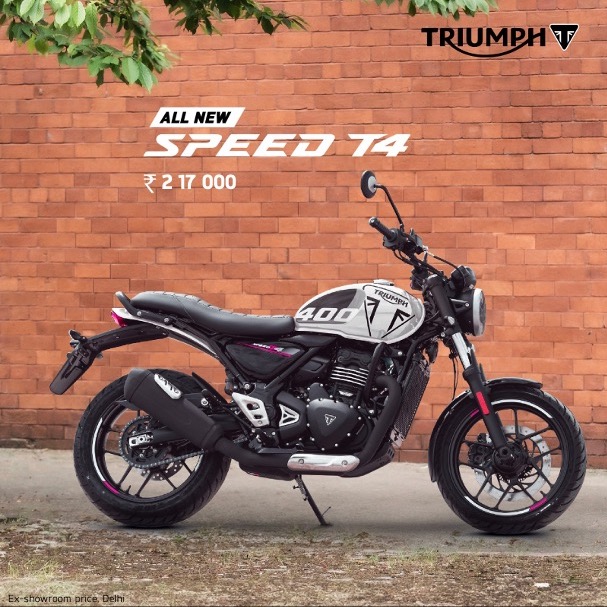Triumph Motorcycles and Bajaj have launched the Speed T4 at INR 2.17 lakh (ex-showroom) and have also updated the Speed 400, which would now be available at INR 2.40 lakh (ex-showroom). Now, while I will tell you about the changes made to the Speed 400 as well, this story will primarily focus on the new motorcycle, the Speed T4, and in the process you will get to know whether it is a Speed 400 Lite (as is being reported by most) or a motorcycle with a completely different character.
Triumph Speed T4: NOT a Speed 400 Lite
Let me give you the spoiler right away—the Speed T4 is NEITHER a base variant, NOR a dumbed-down version, of the Speed 400. And, yes, I am saying that before even riding the Speed T4. There are multiple reasons, which, sadly, have escaped almost all the media houses and YouTubers who were present at the launch.
Engine Gearbox and Final Drive
The Speed T4 carries the same engine as the Speed 400, but the similarities end there. Now, under the Speed T4’s fuel tank, it’s in a totally different state of tune. It produces 31 PS of peak power at 7,000 rpm and 36 Nm of peak torque at 5,000 rpm. For perspective, the Speed 400 produces 40 PS at 8,000 rpm and 37.5 Nm at 6,500 rpm. While the novices would cry at a straight nine-horsepower cut, the more technically inclined amongst you would have already noticed the difference in rpm figures…
If you still haven’t, I will reiterate it for you: the Speed T4 produces its peak power and torque at lesser rpm than the Speed 400. That’s 1,000 less revs for the peak horsepower, and 1,500 less revs for the peak torque. While I would tell you in detail how that translates to on the road as and when I get to ride it, right now, in theory at least, these changes shout out loud that the Speed T4 would turn out to be an even better city motorcycle than the already lovely Speed 400.
In fact, Triumph-Bajaj themselves are saying that the “all-new Speed T4 is for those who like a more relaxed ride.” They also claim that
the Speed T4’s engine produces higher torque between 3,500 rpm and 5,500 rpm “giving you an enhanced low to mid speed rideability with fewer gear shifts.” I say that they are still underplaying the T4’s strength here, as, looking at the torque curves of both the motorcycles, I could see that the T4 actually produces more torque than the Speed 400 right from 2,500 rpm onwards (and not just from 3,500 rpm) up to 5,500 rpm. Not only that, even the idle rpm has come down from 1,500 rpm to 1,300 rpm.
Triumph-Bajaj have been able to achieve this by by adding more inertia (31 per cent more than the Speed 400’s crank, which itself has 50 per cent higher inertia than the Duke 390’s crank) to the crankshaft assembly. The airbox profile has been modified too and the sizing of intake components has been optimised as well to achieve the aforementioned low rpm characteristics.
My favourite part is the omission of Ride By Wire (every manufacturer should have at least one variant without it for us old school chaps). Yes, the Speed T4’s throttle body is totally controlled by your right hand. In other words, the throttle body is now operated by a good old cable setup. Another omission that I like is traction control. Again, all manufacturers should remove traction control from any and every motorcycle that produces less than 60 horsepower. Yes, the Duke 390 shouldn’t have it either.
Also, the Speed T4 gets a 34 mm throttle body as against the 46 mm unit on the Speed 400. Of course, fuel efficiency would be better on the T4.
Now, since the press release didn’t mention anything about the gearbox, I got in touch with the Triumph-Bajaj officials to check if the gearbox is exactly the same in both bikes, and they concurred. The gearbox is the same, and so are all the gear ratios.
Chassis, Suspension, Brakes, Tyres, and Seat Height
The chassis of both the motorcycles is the same; however, the T4 sees a substantial increase in the wheelbase, thanks to the deployment of a conventional fork with a revised steering geometry. The tyres are taller than the original Speed 400 too, but they are now bias ply and not radial.
The suspension travel at the front remains the same, but the monoshock travel has seen a reduction of 10 mm. I must mention here that the new Speed 400 has seen a reduction of 10 mm in suspension travel at both front and rear.
The seat height on the new Speed 400 has gone up too. It is now 803 mm. However, they have altered the profile of the front section of the seat to allow a convenient reach to the ground. The seat height of the T4 is even taller at 806 mm. Again, the seat contours have been redesigned here as well to allow for a convenient reach. Also, both bikes get extra
padding for the pillion perch.
The ground clearance of the new Speed 400 has gone up to 164 mm (from 158 mm) while the T4 boasts a ground clearance of 170 mm.
As far as the brakes are concerned, the rotor sizes remain the same, but the T4 gets axially mounted calipers and organic brake pads.
Other Features
The Speed T4 retains the slipper clutch, instrument cluster, USB port, headlight, tail light, and indicators from the Speed 400. The handlebar is now a steel hydroformed unit, and has been blacked out. In fact, the frame, exhaust, throttle body covers, mudguard, headlamp bracket, and a few other components have been blacked
out as well.
Please note that the exhaust still, thankfully, continues to be a hydroformed unit with no joints. Also, you get conventional stem mirrors on the T4.
Updated Speed 400
The updated Speed 400, in addition to the aforementioned changes in suspension, seat height, and ground clearance, also sees a minor change in the steering geometry and an increase in wheelbase. The new Speed 400 also gets taller tyres (wider than the ones on the T4 and radial), and adjustable levers. The kerb weight has gone up too. It’s now 179 kg (up from 176 kg) while the T4 weighs in at 180 kg.
Colours
The Speed T4 is available in Pearl Metallic White, Cocktail Wine Red, and Phantom Black. The new Speed 400 is available in Racing Yellow, Pearl Metallic White, Racing Red, and Phantom Black.







